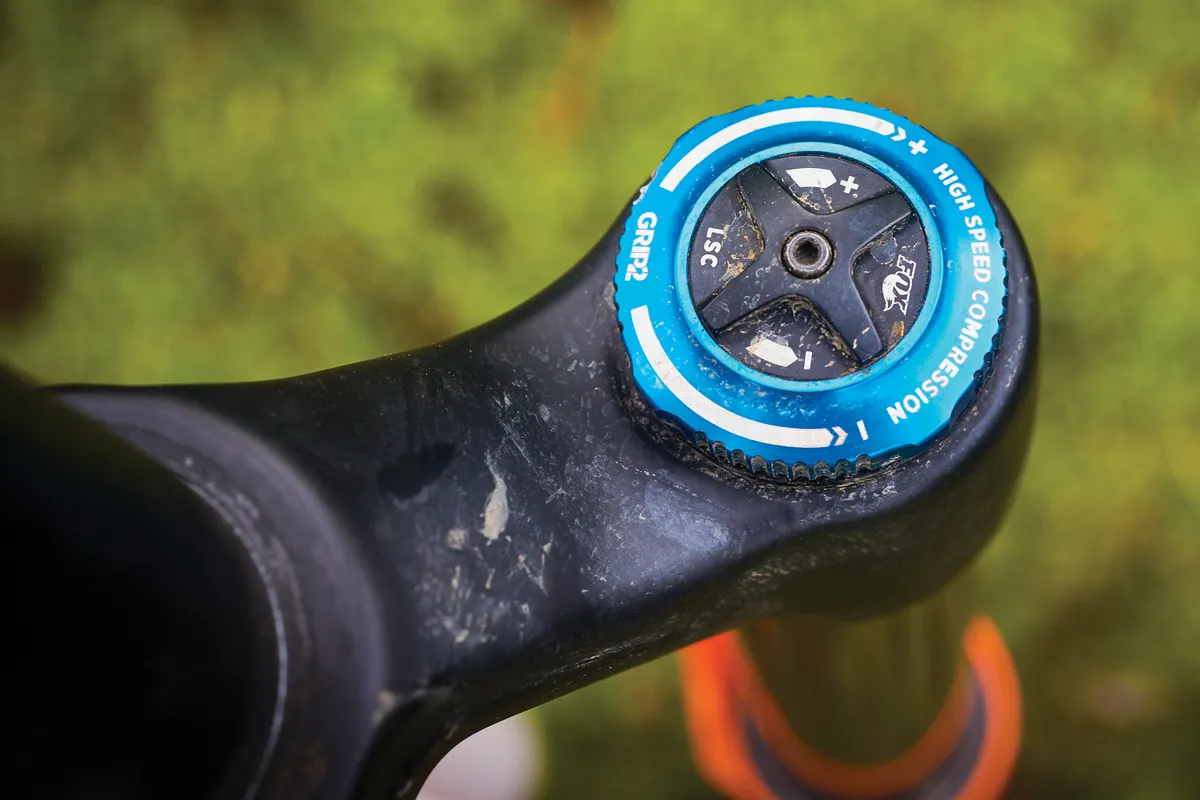Fox has phased out its overly-firm Fit RC2 damper in favour of a more adjustable and potentially suppler GRIP2 unit on its bigger-hitting forks.
- How much suspension travel do I need on my mountain bike?
- How to set up your mountain bike suspension
Fox’s GRIP dampers use the same oil for lubrication in the lowers and inside the damper. This allows Fox to make the damper seals a looser fit, which reduces friction.
When oil forces its way past the seals into the damper, the extra oil is automatically expelled out the top of the damper and back into the lowers.
The GRIP2 damper is the top-end version. It has four adjustments: high- and low-speed compression as well as high- and low-speed rebound damping.
High-speed rebound adjustment is the unusual one here, and while it’s not a feature I missed when returning to other forks, it does make a noticeable difference to the ride.
Basically, Fox’s Variable Valve Control (VVC) rebound valving allows the high-speed rebound (how the fork returns from deep in the travel) to be adjusted somewhat independently of how to the fork responds when it’s closer to sag (low-speed rebound).
- This fork was tested as part of a group test including ten of the best enduro forks. All forks were tested back-to-back on the same tracks, keeping all other variables as consistent as possible to ensure our findings are as reliable and accurate as they can be.
Fox 36 Factory GRIP2 setup

Happily, Fox’s recommended settings, printed on the fork leg, are a good baseline.
After experimenting with different settings, I ended up inside the recommended air pressure window for my weight (88psi for 86kg). It’s a similar story with the high-speed rebound too: adjusting it either way made a small but noticeable difference, but the recommended setting (3–4 clicks from closed) was ideal.
I did set the low-speed rebound a little faster though to keep it feeling supple in high-frequency bumps. I used no volume spacers during the majority of testing and ended up with the high-speed compression fully open. Unless riding slow, steep and technical tracks, I kept low-speed compression towards fully open too.
Fox 36 Factory GRIP2 performance
Despite this lightly damped setup, the fork meters out travel in a carefully controlled way, never diving unduly. It was often surprising how little travel it had used when looking at the O-ring on the stanchion, yet it never felt harsh.
It floats over high-frequency chatter with fluidity and comfort only the RockShox Lyrik can match. On bigger hits it never spikes, but always feels controlled in a sporty, rather than plush, way. It’s stingier with its travel than the Lyrik, but this is not necessarily a bad thing.
It’s fantastic on steep, natural terrain, but when smashing through rocky terrain for minutes on end, I’d rather have the option to go lighter on high-speed compression.
How does it compare to its main rivals?
Over relentlessly rough terrain, the Lyrik can be setup to be slightly more comfortable because it has the option to go lighter on high-speed compression.
The Lyrik has a softer beginning stroke too, which made the front wheel grip slightly better when lightly loaded on flat corners, particularly when switching from turning in one direction to the other.
On the other hand, the 36 does feel more composed when slamming into big holes, perhaps because its high-speed rebound was set up such that it returned more steadily from deep in the stroke, whereas the Lyrik can be over-keen to recover if you run the spring hard.
Still, in my opinion the Lyrik RC2 just has the edge over the 36 from a pure performance standpoint.
As for the other forks on test, the Fox 36 and RockShox Lyrik are in a class of two. Either one is a great fork, but when you consider the fact the Fox 36 costs £150 more than a Lyrik, it becomes hard to recommend.
Fox 36 Factory GRIP2 options
Travel
- 27.5in: 160, 170, 180mm
- 29in: 160 (tested), 170mm
Offset
- 27.5in: 37mm or 44mm
- 29in: 44mm or 51mm (tested)
This video shows how we tested the forks and how they compare.
Product
| Brand | Fox |
| Price | A$1715.00, £1139.00, $1079.00 |
| Weight | 2091g |
Features
| Wheel size | 29in_700c |
| Offset | 51.0000 |
| Offset | MILLIMETER |
| Travel | 160.0000 |
| Travel | MILLIMETER |
| Features | Crown to axle length: 568mm |
